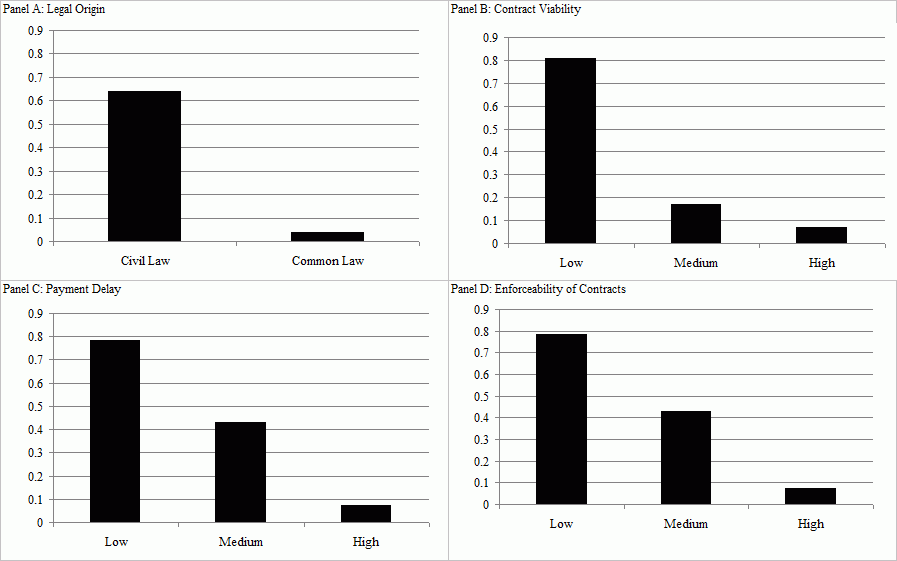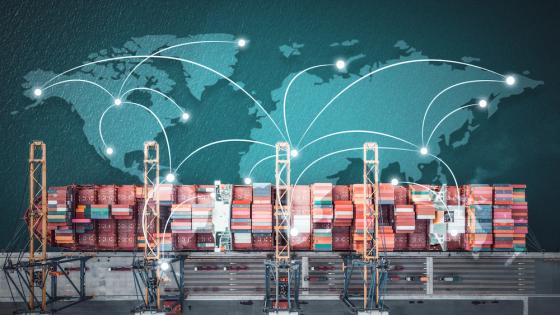During the recent economic crisis, several practitioners claimed that financial constraints contributed to the large decline in global trade flows relative to gross domestic product. Some evidence collected in a survey conducted by the International Chamber of Commerce and in a survey conducted by the IMF and the Banker’s Association for Finance and Trade supported their claims. Policymakers responded with a variety of measures to increase the available of capital for importers and exporters. For example, the IFC’s Global Trade Finance Programme expanded its activities as did the Export-Import Bank of the US and many other export credit agencies around the world.
Although practitioners and policymakers appear to believe that the capital needs associated with trade play an important role, this topic is only beginning to receive the kind of academic attention that is required to help shape policy responses to crises and to create sensible regulations for trade finance providers. One of the main challenges in studying the financing arrangements used to support international trade is that detailed data on how different types of transactions are financed are not readily available.
Despite this, several papers that analyse the recent crisis find that an inability to access capital has large deleterious effects on exports. Baldwin and Evenett (2009) and Auboin (2009) highlight the role of financial constraints. Amiti and Weinstein (forthcoming), and Paravisini et al. (2011a,b) find that a decline in the financial health of a firm’s bank is associated with a decrease in its exports. Chor and Manova (2011) find that countries with tighter credit markets exported less during the crisis, especially in sectors that are financially vulnerable. Only a couple of papers, including Eaton et al. (2010) and Levchenko et al. (forthcoming), suggest that financial considerations play little to no role in understanding the behaviour of trade flows during the recent crisis.
Poultry in motion
In recent research (Antràs and Foley 2011), we attempt to push this research forward by analysing transaction-level data from a US-based firm that exports frozen and refrigerated food products, primarily poultry, to delve into more detail about the different kinds of financing arrangements that are used. Several questions motivate our paper.
- What kinds of financing arrangements are used most commonly?
- How do cross-country differences in contractual enforcement affect the terms that are selected and the prices that are charged in transactions that are financed in different ways?
- Can the development of a relationship between traders mitigate concerns associated with weak institutional environments?
- How does the manner in which trade is financed shape the impact of shocks like the recent crisis on trade flows?
The approach we take is somewhat distinctive. We begin by presenting several facts that emerge from a descriptive look at the data and use these to discipline the development of a theoretical model in which contracts may not be enforced. In this model, the financing terms can require the importer to prepay the exporter for traded goods, and this arrangement creates risk for the importer because goods may not be delivered according to specification. The terms can allow the importer to pay the export some period of time after the goods have been delivered, and under these terms the exporter may not be paid in full. Alternatively, the importer and exporter can make use of a letter of credit, which is costly but includes provisions that push the exporter to perform his obligations and replaces the risk of the importer with the risk of the importer’s bank.
Several findings emerge from empirical analyses that are justified in our theory and have notable implications. First, the most commonly used financing terms do not involve direct financial intermediation by banks. They are cash in advance terms and open account terms; these are used for 44.0% and 39.2% of the value of transactions, respectively. Anecdotal evidence suggests that the use of letters of credit is more common in other industries, but even there, cash in advance and open account terms appear to be predominantly used. The implication of this is that for any policy to be truly effective in alleviating financial constraints, it cannot merely have an effect on banking activities related to letters of credit.
Second, we find that importers in countries where contracts are not strongly enforced are typically required to provide more security to the exporter and to prepay for the goods they buy. Figure 1 displays the share of sales that occur on cash in advance terms for sales made to locations classified using four different measures of the enforcement of contracts. Panel A splits countries into groups with civil and common legal origin. Panels B, C, and D characterise countries by their tercile of contract viability, payment delay, and the enforceability of contracts. For each of these proxies, a smaller share of sales occurs on cash in advance terms as the strength of enforcement of contracts increases. Because external finance is costly in environments with weak contractual enforcement, this result implies that those firms that are likely to have the highest costs of obtaining external capital are the ones that need it in order to finance trade. Although we do not directly study changes in contracting environments, policies that improved contractual enforcement have the potential to relax financing constraints associated with trade.
Figure 1. Cash in Advance Share and Enforcement of Contracts
Notes: This figure displays the share of sales that occur on cash in advance terms to jurisdications classified using measures of the stregnth of the enforcement of contracts. In panel A, the first bar indicates the share for countries with a civil law legal origin and the second bar indicates the share for those with a common law legal origin. The bars in panels B, C, and D illustrate share for sales destinations classified by tercile of contract viability, payment delay, and the enforceability of contracts. Contract viability is drawn from the International Country Risk Guide, and it measures the risk of contract modification or cancellation with higher values indicating lower risks. Payment Delay is also drawn from the International Country Risk Guide, and it measures the risk of receiving and exporting payments from a country with higher values indicating lower risks. Enforcement of Contracts comes from Knack and Keefer (1995) and it captures the degree to which contractual agreements are honored with higher values indicating higher enforcement.
Third, as a relationship develops between the exporter we study and an importer, concerns over contractual enforcement appear to subside and transactions become more likely to occur on open account terms. For the first $25,000 of sales, 60.0% of transactions are cash in advance transactions, and this share falls monotonically, reaching 10.9% for sales that bring cumulative sales to values exceeding $5 million. Put differently, relationships can substitute for weak institutional environments. One implication of this finding is that one potential gain from repeated interaction in trade is lower financing costs. Another implication is that steps to facilitate the development of deep trading relationships might have the ancillary benefit of helping capital flow to where it is needed.
Fourth, we find that the manner in which trade is financed shapes the impact of macroeconomic and financial crises like the recent one. Using the theoretical framework developed in the paper, crises can be modelled as a decrease in demand and an increase in the likelihood that liquidity shocks occur. Under these circumstances, importers that were transacting on cash in advance terms before the crisis reduce their purchases the most. Thus, the paper points out that policymakers would be more effective if they took trade finance practices into account when responding to crises.
There is a need for much more research on the topic of trade finance. Although survey evidence suggests that the relative use of alternative financing terms and that the impact of contractual enforcement on the choice of financing terms are similar for firms other than the one we study, analysis of how trade is financed in other settings could reveal new insights about how contracting problems affect international economic activity and about the value of alternative types of collateral. The risks associated with trade finance also have not been well documented, and research on this topic could prevent inappropriate regulation. There is considerable pressure to increase bank capital requirements associated with some trade finance product offerings as a part of Basel III, but it is not clear that levels of risk warrant such changes. Additional research could be invaluable to guiding crucial policy choices.
References
Antràs, Pol, and C Fritz Foley (2011), "Poultry in Motion: A Study of International Trade Finance Practices", NBER Working Paper 17091.
Amiti, Mary, and David Weinstein (forthcoming), "Exports and Financial Shocks," Quarterly Journal of Economics.
Auboin, Marc (2009), "Restoring Trade Finance: What the G20 Can Do," in Richard Baldwin and Simon Evenett (eds.), The Collapse of Global Trade, Murky Protectionism, and the Crisis: Recommendations for the G20, A VoxEU.org Publication, 5 March.
Baldwin, Richard, and Simon Evenett (eds.) (2009), The Collapse of Global Trade, Murky Protectionism, and the Crisis: Recommendations for the G20, A VoxEU.org Publication, 5 March.
Chor, Davin and Kalina Manova (forthcoming), "Off the Cliff and Back? Credit Conditions and International Trade during the Global Financial Crisis", Journal of International Economics.
Eaton, Jonathan, Sam Kortum, Brent Neiman, and John Romalis (2010), "Trade and the Global Recession", working paper.
Levchenko, Andrei A, Logan Lewis, and Linda L Tesar (2010), "The Collapse of International Trade during the 2008-2009 Crisis: In Search of the Smoking Gun", IMF Economic Review, 58(2):214-253.
Paravisini, Daniel, Veronica Rappoport, Philipp Schnabl, and Daniel Wolfenzon (2011a), "Dissecting the Effect of Credit Supply on Trade: Evidence from Matched Credit-Export Data", NBER Working Paper 16975.
Paravisini, Daniel, Veronica Rappoport, Philipp Schnabl, and Daniel Wolfenzon (2011b), "Credit constraints and the great trade collapse", VoxEU.org, 27 July.



